

 The Douglas XB-19, carrying Army
serial number 38-471, was the largest airplane in the world when
it first flew in 1941. These illustrations of the XB-19 appeared
in magazines in the 1940s.
The Douglas XB-19, carrying Army
serial number 38-471, was the largest airplane in the world when
it first flew in 1941. These illustrations of the XB-19 appeared
in magazines in the 1940s.
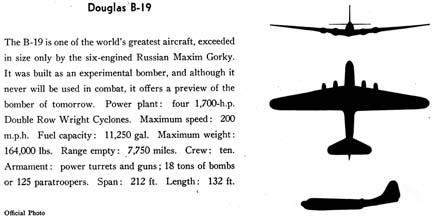 Specifications for the Douglas
XB-19. It was intended to carry a 36,000-pound bomb load for
2,000 miles.
Specifications for the Douglas
XB-19. It was intended to carry a 36,000-pound bomb load for
2,000 miles.
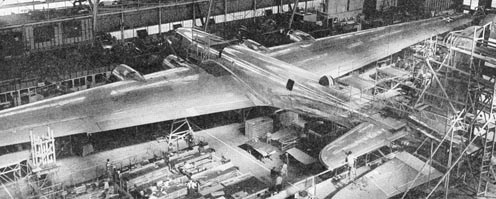 The XB-19 nears completion in the
Douglas factory at the Santa Monica Airport. It was the first
bomber equipped with tricycle landing gear and power-boosted
controls.
The XB-19 nears completion in the
Douglas factory at the Santa Monica Airport. It was the first
bomber equipped with tricycle landing gear and power-boosted
controls.
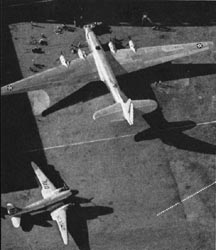 The XB-19 was enormous in
comparison to what was the jumbo airliner of its day, the Douglas
DC-3. The U. S. Government paid $1,400,064 for it and Douglas
spent almost $4,000,000 in company funds to complete it.
The XB-19 was enormous in
comparison to what was the jumbo airliner of its day, the Douglas
DC-3. The U. S. Government paid $1,400,064 for it and Douglas
spent almost $4,000,000 in company funds to complete it.
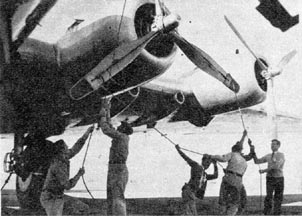 Pulling the props through before
starting the engines required the combined efforts of six men,
two each pulling on the ropes attached to the three propeller
blades. The propellers were rotated a few revolutions to expell
lubricating oil which collected in the lower cylinders.
Pulling the props through before
starting the engines required the combined efforts of six men,
two each pulling on the ropes attached to the three propeller
blades. The propellers were rotated a few revolutions to expell
lubricating oil which collected in the lower cylinders.
 The XB-19 taxiing around the Santa
Monica Airport. The great weight of the airplane on its single
8-foot diameter main wheels actually broke through the pavement
in places.
The XB-19 taxiing around the Santa
Monica Airport. The great weight of the airplane on its single
8-foot diameter main wheels actually broke through the pavement
in places.
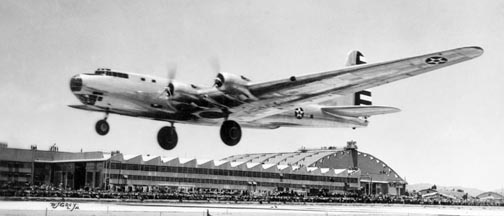 A crowd of Douglas Aircraft Company
employees lines the tarmac (and a few hardy souls are perched on
the rooftops) at the Santa Monica Airport as the XB-19 takes to
the air for the first time on June 27, 1941. Major Stanley
Umstead piloted the XB-19 on this 55-minute flight to March Field
near Riverside, California. This image is from a postcard made
from an actual photographic print by W. J. Gray of Los Angeles.
A crowd of Douglas Aircraft Company
employees lines the tarmac (and a few hardy souls are perched on
the rooftops) at the Santa Monica Airport as the XB-19 takes to
the air for the first time on June 27, 1941. Major Stanley
Umstead piloted the XB-19 on this 55-minute flight to March Field
near Riverside, California. This image is from a postcard made
from an actual photographic print by W. J. Gray of Los Angeles.
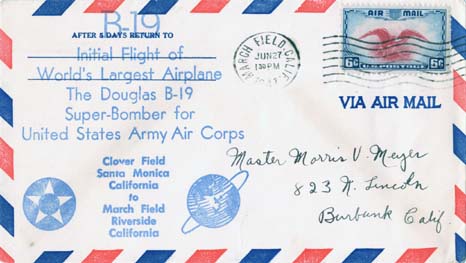 This air mail envelope was on board the
XB-19 when the photograph above was taken.
This air mail envelope was on board the
XB-19 when the photograph above was taken.
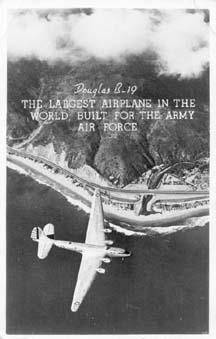 The XB-19
cruises over the coast of southern California. Does anybody
recognize the location? Perhaps Malibu Point? This is a photo
postcard of the Grover Photo Company of Danville Illinois. It was
mailed in July 1943. In fact the XB-19 was the third largest
airplane built at the time.
The XB-19
cruises over the coast of southern California. Does anybody
recognize the location? Perhaps Malibu Point? This is a photo
postcard of the Grover Photo Company of Danville Illinois. It was
mailed in July 1943. In fact the XB-19 was the third largest
airplane built at the time.
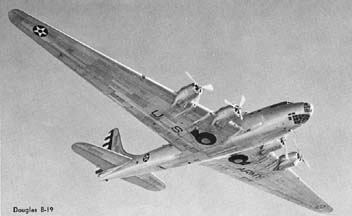 The main gear wheels retracted
nearly flush with the lower surface of the wing. A tunnel in the
wing allowed crewmen to access the engines in flight.
The main gear wheels retracted
nearly flush with the lower surface of the wing. A tunnel in the
wing allowed crewmen to access the engines in flight.
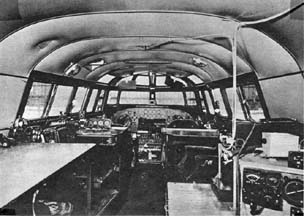 Cockpit and flight engineer's
stations of the XB-19.
Cockpit and flight engineer's
stations of the XB-19.
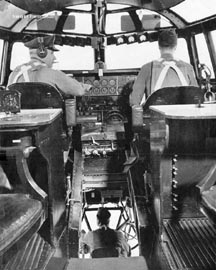 The XB-19 featured a capacious
bombardiers station below the cockpit. The pilot in the left-hand
seat is Major Stanley Umstead.
The XB-19 featured a capacious
bombardiers station below the cockpit. The pilot in the left-hand
seat is Major Stanley Umstead.
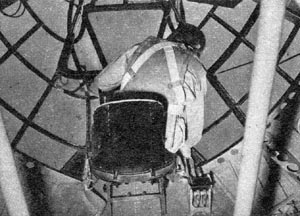 The view from the bombardier's
station was magnificent.
The view from the bombardier's
station was magnificent.
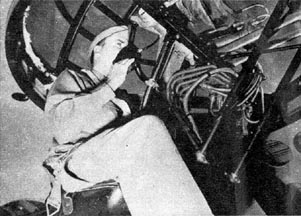 Upper turret gunner's station. The
XB-19 bristled with guns. The nose turret and the forward dorsal
turret were each equipped with a 37mm cannon and a .30-calibre
machine gun. The rear dorsal turret, the ventral turret, the tail
gunner's station, and a station on each side of the rear fuselage
were each provided with one .50-calibre machine. The bombardier
was provided with a pair of .30-calibre machine guns located to
either side of the bomb aiming station. Another pair .30-calibre
machine gun was located in the rear fuselage under the horizontal
stabilizers.
Upper turret gunner's station. The
XB-19 bristled with guns. The nose turret and the forward dorsal
turret were each equipped with a 37mm cannon and a .30-calibre
machine gun. The rear dorsal turret, the ventral turret, the tail
gunner's station, and a station on each side of the rear fuselage
were each provided with one .50-calibre machine. The bombardier
was provided with a pair of .30-calibre machine guns located to
either side of the bomb aiming station. Another pair .30-calibre
machine gun was located in the rear fuselage under the horizontal
stabilizers.
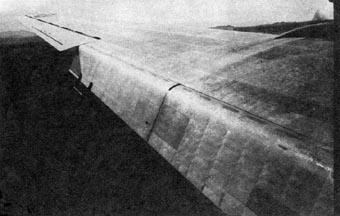 The wing of the XB-19 was equipped
with large simple hinged flaps and two sets of 45-foot long
ailerons.
The wing of the XB-19 was equipped
with large simple hinged flaps and two sets of 45-foot long
ailerons.
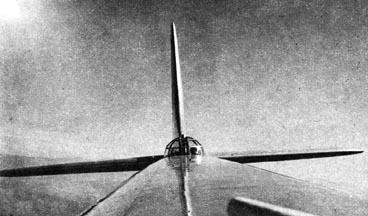 View aft along the upper fuselage.
View aft along the upper fuselage.
 Initially the XB-19 was powered by
four 2,000 horsepower Wright Cyclone R-3350-5 eighteen-cylinder
radial engines.
Initially the XB-19 was powered by
four 2,000 horsepower Wright Cyclone R-3350-5 eighteen-cylinder
radial engines.
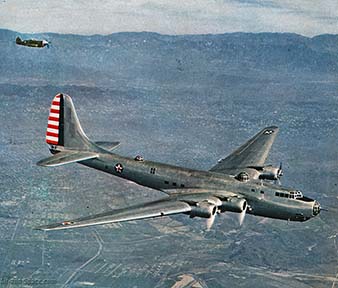 XB-19 with a
Curtiss P-40 chase plane over what is now south-central Los
Angeles in 1941. I am not sure if this is an actual color photo
or a tinted black-and-white photo. Following the attack on Pearl
Harbor, the XB-19 was camouflaged with olive drab over gray. Its
guns were loaded with ammunition and the gunner's stations were
manned during its subsequent test flights at March Field.
XB-19 with a
Curtiss P-40 chase plane over what is now south-central Los
Angeles in 1941. I am not sure if this is an actual color photo
or a tinted black-and-white photo. Following the attack on Pearl
Harbor, the XB-19 was camouflaged with olive drab over gray. Its
guns were loaded with ammunition and the gunner's stations were
manned during its subsequent test flights at March Field.
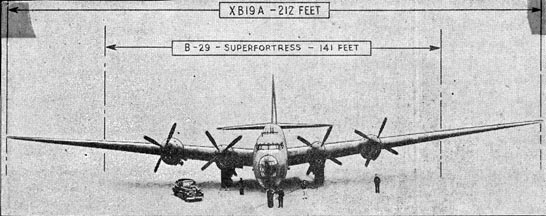 The XB-19 became the XB-19A when it
was re-engined with four 2,600-horsepower Allison V-3420-11
twenty-four cylinder engines in 1944. Each engine was essentially
two Allison V-1710 twelve-cylinder engines placed side-by-side
and connected to a propeller through a common crankcase. The top
speed of the airplane rose from 204 miles per hour to 265 miles
per hour. Development problems with the crankcase restricted the
V-3420 to use on just a few airplane types.
The XB-19 became the XB-19A when it
was re-engined with four 2,600-horsepower Allison V-3420-11
twenty-four cylinder engines in 1944. Each engine was essentially
two Allison V-1710 twelve-cylinder engines placed side-by-side
and connected to a propeller through a common crankcase. The top
speed of the airplane rose from 204 miles per hour to 265 miles
per hour. Development problems with the crankcase restricted the
V-3420 to use on just a few airplane types.
The XB-19A was flown to Davis-Monthan Air Force Base near Tucson, Arizona on August 17, 1946 and placed into storage. That same month it lost its status as the largest airplane in the United States when Consolidated-Vultee completed the XB-36. It sat in the desert for three years, and then the airplane, which should have been the centerpiece of the newly created Air Force Museum, was cut up for scrap metal. The only surviving components of the XB-19 are two of its main gear wheels displayed at the Hill AFB museum in Utah and the National Museum of the USAF in Ohio.
Pre-World War II Giant Airplanes |
||||||
| First Flight | Wing Span | Length | Wing Area | Gross Weight | Engines | |
| Douglas XB-19 | 1941 |
212ft,00in |
132ft,00in |
4,492 |
164,000 |
4 x 2,000 hp R3350 |
| Tupolev Ant-20bis | 1940 |
206ft,08in |
111ft,11in |
5,231 |
99,200 |
6 x 1,200 hp M-34FRNV |
| Martin PBM Mariner | 1939 |
118ft,00in |
79ft,00in |
1,408 |
41,000 |
4 x 1,700 hp R2800 |
| Boeing 314 | 1938 |
152ft,00in |
106ft,00in |
2,607 |
82,000 |
4 x 1,200 hp R2,600 |
| Boeing 307 Stratoliner | 1938 |
107ft,03in |
74ft,04in |
1,486 |
42,000 |
4 x 900 hp R1820 |
| Convair PB2Y Coronado | 1937 |
115ft,00in |
79ft,00in |
1,780 |
63,000 |
4 x 1,000 hp R1830 |
| Boeing XB-15 | 1937 |
149ft,00in |
87ft,07in |
2,780 |
70,700 |
4 x 1,000 hp R1830 |
| Boeing Model 299 | 1935 |
103ft,09in |
68ft,09in |
1,420 |
38,000 |
4 x 750 hp R1690 |
| Tupolev Maxxim Gorky | 1934 |
206ft,08in |
107ft,11in |
5,231 |
92,600 |
8 x 900 hp M-34FRN |
Go to the home page of the Goleta Air and Space Museum.
Send a message to Brian.